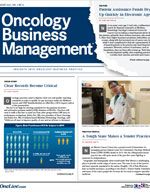Publication
Article
Special Issues
Innovation Brings New Challenges
Author(s):
The right technology can make a wonderful difference, but what if everybody has it? Such is the case with patient assistance-funding software, the use of which is now becoming widespread.
OncLive Chairman,
Mike Hennessy
The right technology can make a wonderful difference, but what if everybody has it? Such is the case with patient assistance-funding software, the use of which is now becoming widespread. The need for patient assistance is so great that funds earmarked for particular forms of cancer can be depleted between the time you start filling out an electronic application and the time you finish, Gina Battaglia reports in a feature story this month in Oncology Business Management.
“The foundations and drug manufacturers are doing their best to keep up, but the demand has gotten out of hand,” Robin Zon, MD, a medical oncologist practicing at Michiana Hematology Oncology in Indiana, is quoted as saying. Read about the promise and the limitations of patient assistance search technology in Battaglia’s story.
Emily Brill wrote her debut story for Oncology Business Management this month by revisiting the subject of ICD-10 diagnostic codes. There was enough excitement last year when practices had to ready themselves for the launch of thousands of new codes. They prepared well for it, and there was no significant increase in claim denials. This October, though, marks the end of a grace period during which practices have not had to code with extreme specificity. October 1 will also bring with it several thousand new codes for practices to start using—and potentially one for the Zika virus, too, depending on the outcome of a World Health Organization vote. Read the ICD-10 story and see how coding experts expect oncology practices to fare during the post-October 2016 ICD-10 transition.
All eyes turned to CMS in July as Acting Administrator Andy Slavitt told Congress the well-intentioned Medicare Access and CHIP Reauthorization Act (MACRA) could have the unwanted effect of accelerating the speed at which independent practices are disappearing from the landscape. “We need to launch this program so that it begins on the right foot,” Slavitt said. “And that means that every physician in the country needs to feel like they are set up for success.” Our stories this month on MACRA talk about some of the implications of that statement.
Ron Kline, MD, medical officer in the Patient Care Models Group in the CMS Innovation Center, gave us an exclusive interview about the Oncology Care Model (OCM) launch and discussed some of the issues that are making this a challenging program to implement—both for practices and CMS. Kline sees room for savings and better patient outcomes even at the best oncology practices in the United States.
One of the practices that will attempt to implement the OCM is already battle-tested—if that will help it to succeed. In a region where the dominant insurer is trying to force its policy holders to use the facilities it owns and the doctors it employs, New Mexico Cancer Center— the subject of our practice profile this month—has used a combination of innovation and litigation to maintain its independence. The practice helped to create the oncology medical home care model, set up a foundation to help patients with non-medical expenses, and spent the last four years fighting an antitrust lawsuit to prevent the dominant insurer from ending its service contract.
It’s all good reading this month in Oncology Business Management!





























%20(2)%201-Recovered-Recovered-Recovered-Recovered-Recovered-Recovered-Recovered-Recovered-Recovered-Recovered-Recovered-Recovered-Recovered-Recovered-Recovered-Recovered-Recovered.jpg?fit=crop&auto=format)
%20(2)%201-Recovered-Recovered-Recovered-Recovered-Recovered-Recovered-Recovered-Recovered-Recovered-Recovered-Recovered-Recovered-Recovered-Recovered-Recovered-Recovered-Recovered.jpg?fit=crop&auto=format)
